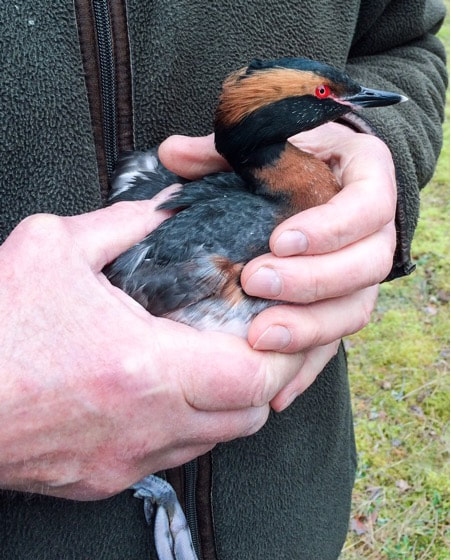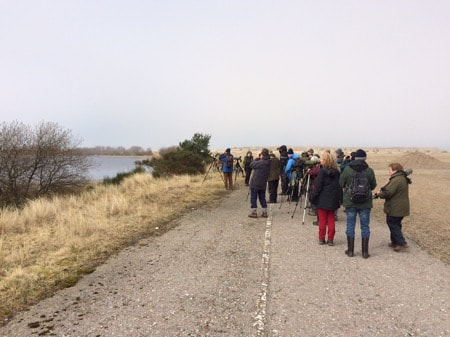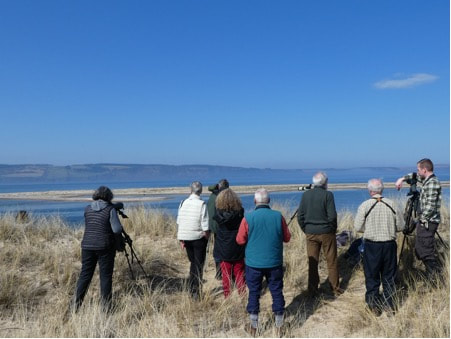A look out the window at 6:30AM and I was horrified with what I saw, or rather what I couldn't see. Thick fog sitting all around the village, if it was bad here then the coast would almost certainly be the same. A quick check of various weather forecasts though reassured me that within a couple of hours it would burn off.
So two hours later we were heading down to Fort George to meet with members of both the Highland and Moray SOC groups for the annual joint field trip, this year it was to Whiteness Head & Fort George.
The thick Haar was still causing problems but events were about to take a surprising and dramatic twist. Whilst driving past the playing fields between Ardersier & Fort George, Kate in the passenger seat suddenly yelled "Stop there's a Slav in the field!" A quick reverse followed by a bit of sprinting from us both resulted in a beautiful adult female Slavonian grebe taken into care a few minutes later. It had become apparent whilst catching the bird that she was unable to take off from the field, presumably only able to take off from the surface of water and in the thick haar must have mistaken the flat playing field for the adjacent sea. As we were meeting the rest of the SOC group less than 10 minutes later a local friend was contacted who was able to come and collect her and weigh her, confirming that she was an extremely healthy weight, there were no obvious injuries and she was released at the coast where she was seen to swim off strongly before taking off and flying further out to sea.
So two hours later we were heading down to Fort George to meet with members of both the Highland and Moray SOC groups for the annual joint field trip, this year it was to Whiteness Head & Fort George.
The thick Haar was still causing problems but events were about to take a surprising and dramatic twist. Whilst driving past the playing fields between Ardersier & Fort George, Kate in the passenger seat suddenly yelled "Stop there's a Slav in the field!" A quick reverse followed by a bit of sprinting from us both resulted in a beautiful adult female Slavonian grebe taken into care a few minutes later. It had become apparent whilst catching the bird that she was unable to take off from the field, presumably only able to take off from the surface of water and in the thick haar must have mistaken the flat playing field for the adjacent sea. As we were meeting the rest of the SOC group less than 10 minutes later a local friend was contacted who was able to come and collect her and weigh her, confirming that she was an extremely healthy weight, there were no obvious injuries and she was released at the coast where she was seen to swim off strongly before taking off and flying further out to sea.
We hoped this was to set a precedent for the rest of the day wondering what other birds of interest the fog may have brought down. There were 20 SOC members in total who turned up, mostly from the Highland area but also a hardcore showing from Moray who were clearly keen to experience birding on the other side of the wall!. The original plan had been to have a look from both sides of Fort George as the rising tide was likely to get the day list off to a good start. Given that we couldn't even see the sea despite being less than 100 yards from us this plan was postponed for later in the day. After a quick introduction as to what the day was hopefully going to entail we climbed back into our vehicles and drove the short distance into the woods at the Carse of Ardersier.
Here at least visibility was adequate enough to see at least the immediate trees around us. We spent longer in the woods than planned hoping to give the weather time to burn off, alas this didn't happen and very few birds were calling or active with just a mistle thrush and a few chiffchaffs belting out there song refusing to be silenced. A few members of the group were lucky to catch a glimpse of a quick Jay flitting past and even common species like goldfinch and siskin did give themselves up for us but not easily.
We emerged from the woodland onto the MOD ground, this involved a scramble through a gorse covered fence which has been built in recent weeks to prevent off-road bikes accessing the area. Unfortunately the gorse makes it rather birder proof too but the SOC were a determined lot and would not be deterred by a few prickles and braved the pain, keen to see what new birds we could see.
On the heath, again visibility was an issue and there was little activity, despite it now being about 11AM and with no sign of the weather improving we decided to have a look at the marsh. The marsh is usually a hive of activity both on the water and in the scrub surrounding it. Just three pairs of coots on nests, a couple of immature mute swans, a moorhen and a handful of mallard and teal were present. A little grebe put in a couple of appearances but the pair of gadwall and small flock of wigeon which had been present for the past few months including the previous day were nowhere to be seen. It really felt as if the weather really was having the last laugh.
Having exhausted all the other diversions and habitats and with high tide almost upon us we couldn't delay going to the coast any longer so we walked up the track towards the bay, noting on the way the flags which had been up around the firing range earlier in the morning had now been taken down suggesting even the army had been beaten by the poor visibility!
On arriving at the bay we were all relieved to at least be able to see the roost on the opposite sand spit, this comprised mainly of sandwich terns and oystercatchers but with a bit of searching we managed to pick out a single common tern plus a handful of dunlin and ringed plover, a number of shelduck were also dabbling about in the shallows.
We pushed on, crossing onto the track which runs around the back of the lagoon and onto the old fabrication yard. From here we were able to scope across the lagoon and were pleased to see there were some birds here including the missing gadwall pair and wigeon from the marsh. There were also tufted ducks, displaying goldeneye and a pair of adult mute swans on a nest.
Here at least visibility was adequate enough to see at least the immediate trees around us. We spent longer in the woods than planned hoping to give the weather time to burn off, alas this didn't happen and very few birds were calling or active with just a mistle thrush and a few chiffchaffs belting out there song refusing to be silenced. A few members of the group were lucky to catch a glimpse of a quick Jay flitting past and even common species like goldfinch and siskin did give themselves up for us but not easily.
We emerged from the woodland onto the MOD ground, this involved a scramble through a gorse covered fence which has been built in recent weeks to prevent off-road bikes accessing the area. Unfortunately the gorse makes it rather birder proof too but the SOC were a determined lot and would not be deterred by a few prickles and braved the pain, keen to see what new birds we could see.
On the heath, again visibility was an issue and there was little activity, despite it now being about 11AM and with no sign of the weather improving we decided to have a look at the marsh. The marsh is usually a hive of activity both on the water and in the scrub surrounding it. Just three pairs of coots on nests, a couple of immature mute swans, a moorhen and a handful of mallard and teal were present. A little grebe put in a couple of appearances but the pair of gadwall and small flock of wigeon which had been present for the past few months including the previous day were nowhere to be seen. It really felt as if the weather really was having the last laugh.
Having exhausted all the other diversions and habitats and with high tide almost upon us we couldn't delay going to the coast any longer so we walked up the track towards the bay, noting on the way the flags which had been up around the firing range earlier in the morning had now been taken down suggesting even the army had been beaten by the poor visibility!
On arriving at the bay we were all relieved to at least be able to see the roost on the opposite sand spit, this comprised mainly of sandwich terns and oystercatchers but with a bit of searching we managed to pick out a single common tern plus a handful of dunlin and ringed plover, a number of shelduck were also dabbling about in the shallows.
We pushed on, crossing onto the track which runs around the back of the lagoon and onto the old fabrication yard. From here we were able to scope across the lagoon and were pleased to see there were some birds here including the missing gadwall pair and wigeon from the marsh. There were also tufted ducks, displaying goldeneye and a pair of adult mute swans on a nest.
By now it had gone midday and hunger was starting to set in so we traipsed across the yard towards the sand dunes which overlook Whiteness spit, as we did so we were all delighted to feel the sun beginning to burn through and watch as visibility gradually began to improve. By the time we nestled ourselves down into the dunes with a suitable vantage point we were able to at least make out the spit and a small amount of sea beyond. During the course of our lunch the mist lifted sufficiently until we could see all of the black isle and in the opposite direction across the invisible boundary just a few hundred meters away into the Moray recording area.
The sun coming out was great timing and as well as the haar lifting so did our spirits. Here birds were added to the day list thick and fast, highlights being three white-wagtails on the spit, a pair of black-throated divers in addition to several red-throats, guillemot and razorbill, gannets, a few fulmar and kittiwakes. Plenty of mergansers were displaying in the channel below us and smaller numbers of long-tailed and eider ducks were also present including a few hauled out onto the spit itself. The very distant scoter flock way out in the firth was just about visible with a scope. Shags and cormorants were busy fishing in the sea and on the spit itself were a small flock of dunlin and sanderling whilst ringed plover scuttled amongst them. The odd redshank flew past and sandwich terns were present the entire time fishing for their lunch in front of us as we ate ours.
The sun coming out was great timing and as well as the haar lifting so did our spirits. Here birds were added to the day list thick and fast, highlights being three white-wagtails on the spit, a pair of black-throated divers in addition to several red-throats, guillemot and razorbill, gannets, a few fulmar and kittiwakes. Plenty of mergansers were displaying in the channel below us and smaller numbers of long-tailed and eider ducks were also present including a few hauled out onto the spit itself. The very distant scoter flock way out in the firth was just about visible with a scope. Shags and cormorants were busy fishing in the sea and on the spit itself were a small flock of dunlin and sanderling whilst ringed plover scuttled amongst them. The odd redshank flew past and sandwich terns were present the entire time fishing for their lunch in front of us as we ate ours.
All feeling better for being fed, watered and having the sun on our faces we departed with a spring in our step. We made our way back across the yard, the air filled by the sound of skylarks, there was no sign of any sand martins back at the colony yet but those at the back of the group picked up a wheatear.
Back at the bay, the tide was going out fast but the sandwich terns were still present and being as raucous as ever, a bar-tailed godwit feeding in the receding water was a new addition. As we made our way back down the track a large flock of well over a thousand pink-feet flew low overhead and landed on the firth just beyond the bay leaving us all gazing in awe at the spectacle. We continued into the willow scrub where our first willow warbler of the year gave out a few bursts of song, it was repeatedly drowned out by much louder, closer and more numerous chiffchaffs but most of the group were able to hear it after a bit of perseverance but it was too far through the scrub for anyone to see.
The rest of the walk back was similar to the walk out but the sunshine making it far more enjoyable. A treecreeper and long-tailed tits were picked up in the woodland and a pair of sparrowhawks displaying overhead was something we all paused to admire.
We returned to the vehicles and headed back to Fort George where the other cars had been left. A few folk departed at this point having long journeys home or prior engagements but the remaining birders made the short walk to view the coast from either side of the fort. By now the tide was a fair way out but a greenshank was a surprise bonus on the Nairn side of the fort. Whilst on the Ardersier side, there were more bar-tailed godwits in the bay , a group of turnstone were picking about in some seaweed and one of the resident magpies was picked up distantly. These being the final additions of the day, brought the combined effort total up to a respectable 83 species. Considering the adverse weather conditions throughout over half of the trip it doesn't seem too shabby.
With any luck it will have whet the appetite of some people who are unfamiliar with the site and encourage them to come back in their own time to enjoy this diverse and promising site on the edge of the Highlands. Once they have checked the weather forecast first of course...
Written by Jon Clarke
Back at the bay, the tide was going out fast but the sandwich terns were still present and being as raucous as ever, a bar-tailed godwit feeding in the receding water was a new addition. As we made our way back down the track a large flock of well over a thousand pink-feet flew low overhead and landed on the firth just beyond the bay leaving us all gazing in awe at the spectacle. We continued into the willow scrub where our first willow warbler of the year gave out a few bursts of song, it was repeatedly drowned out by much louder, closer and more numerous chiffchaffs but most of the group were able to hear it after a bit of perseverance but it was too far through the scrub for anyone to see.
The rest of the walk back was similar to the walk out but the sunshine making it far more enjoyable. A treecreeper and long-tailed tits were picked up in the woodland and a pair of sparrowhawks displaying overhead was something we all paused to admire.
We returned to the vehicles and headed back to Fort George where the other cars had been left. A few folk departed at this point having long journeys home or prior engagements but the remaining birders made the short walk to view the coast from either side of the fort. By now the tide was a fair way out but a greenshank was a surprise bonus on the Nairn side of the fort. Whilst on the Ardersier side, there were more bar-tailed godwits in the bay , a group of turnstone were picking about in some seaweed and one of the resident magpies was picked up distantly. These being the final additions of the day, brought the combined effort total up to a respectable 83 species. Considering the adverse weather conditions throughout over half of the trip it doesn't seem too shabby.
With any luck it will have whet the appetite of some people who are unfamiliar with the site and encourage them to come back in their own time to enjoy this diverse and promising site on the edge of the Highlands. Once they have checked the weather forecast first of course...
Written by Jon Clarke



 RSS Feed
RSS Feed
